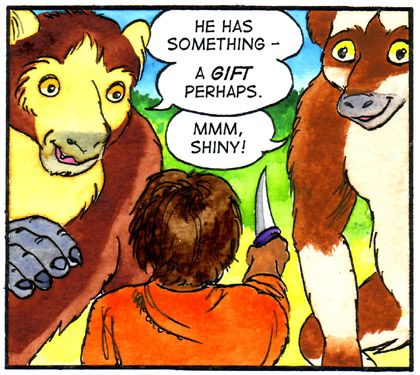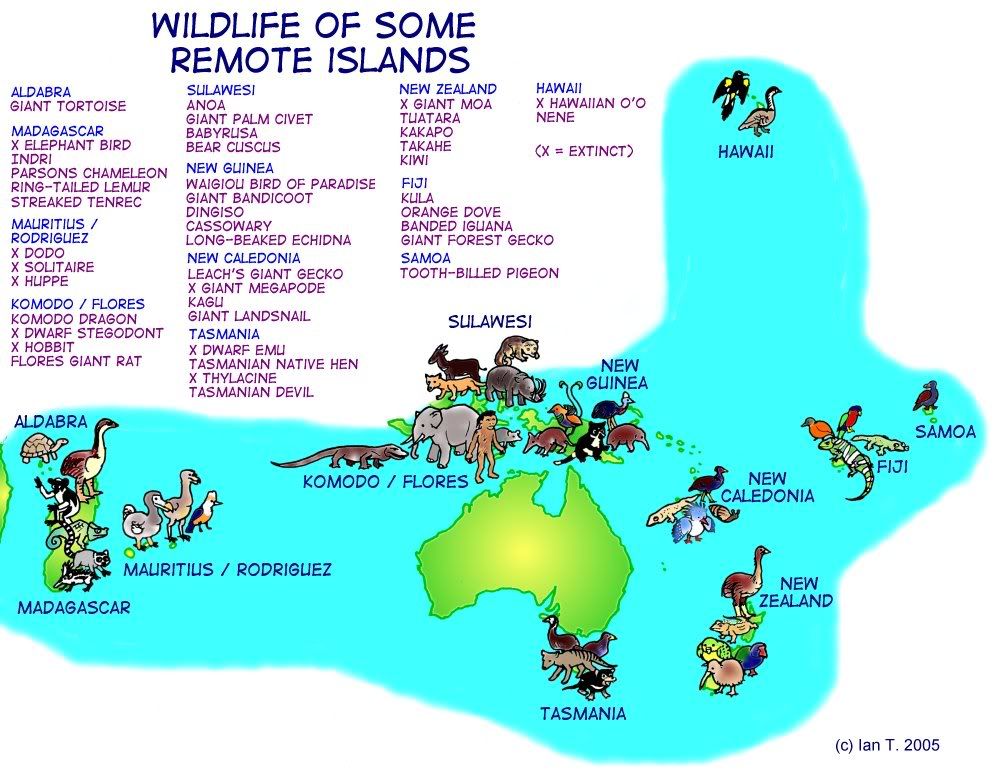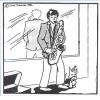Saturday, June 09, 2012
Shiny for Illustration Friday

A single panel from my tale in the recent Beginnings Australian comic anthology, featuring two giant lemurs and one small boy.
Labels: Australian comics, Beginnings, Illustration Friday, island wildlife
Monday, March 12, 2012
Paradise in Beginnings anthology
The fantastic all colour, nearly 200 page Australian comics anthology, Beginnings, has just been released. It's a limited edition, so you'll need to hurry - order at: Beginnings shop.
This amazing cover design is by Jon Sommariva - I love his interpretations of all the characters, particularly mine (you can figure out who those are by buying a copy :) ). The book came about as a result of the ACT Comic Meet. I've appeared in other books with some of these fine artists, so when this anthology was first announced I knew it would be something special, and was keen to be involved.
My contribution is a 7 page story called "Paradise." I had a few ideas - the origin story of a Moth & Tanuki character, the first eight pages of a children's comic project I've started on, or the first chapter of one of the graphic novels on my neglected script slush pile - after running these ideas past Jill, I was surprised to find which one seemed the best choice.
While I'd had the character designs for a while I wasn't sure where to begin. Somehow pencilled sketches seemed to best capture these characters. I gave L. the first draft of scribbles to see what she thought and even like that, it seemed to work as a story in its own right.
For a while now I've been feeling disillusioned with computer art. There's a sameness to it that bothers me - a homogenising effect - that makes it seem like microwave food a lot of the time. Also, my eyes have usually had enough of staring at a screen after work.
I was also feeling tired of working with pens and thought they weren't right for this. The hottest days of Summer didn't seem like the logical time to be refilling them either (I have some work stored up for inking when the weather cools down).
After doing some large, fairly tightly pencilled pages, I experimented with "hardening" the linework on the computer and then printing it out onto watercolour paper. That puts a bit of a break in the organic process I'd wanted, but the results were just right! I broke out the watercolour paints and worked on all the pages at once. Brushes really are the most enjoyable tool to work with, and colouring this way was much faster than using Photoshop.
After I sent my submission in (pleading that it start on a right hand page), I received a request for a splash page. The picture at left was sketched hastily in pencil in my morning tea break and then painted that night. The only problem was scanning it while the paint was still damp.
 While I'm on it, my comic stories are paced and designed to work according to the page turns, and placement of the pages at right and left is vital. I've had stories in the past ruined by them starting on the left instead of the right (it can also ruin the ending). With this book I didn't need to worry: the ACT Comic Meet is a collective of talented artists and this book has been put together by the editors with real care and attention to detail.
While I'm on it, my comic stories are paced and designed to work according to the page turns, and placement of the pages at right and left is vital. I've had stories in the past ruined by them starting on the left instead of the right (it can also ruin the ending). With this book I didn't need to worry: the ACT Comic Meet is a collective of talented artists and this book has been put together by the editors with real care and attention to detail.I've really enjoyed this project and look forward to seeing the finished book - if you're quick, you might even land a copy before me!
Beginnings
Labels: Australian comics, Beginnings, island wildlife, Miscellaneous comic pieces
Thursday, October 27, 2005
Remote for Illustration Friday
Please click on picture and resize for larger version:

For me, "Remote" really brought up the concept of geographical isolation. Two excellent books have gotten me thinking about island zoology and biodiversity again: David Quammen's The Song of the Dodo and the beautiful photographic book South Sea Islands: a Natural History by Rod Morris and Alison Ballance. I also had a number of Tim Flannery's books in mind while composing this.
This is very much an Illustration (complete with explanatory text) rather than a work of art :). I've wanted to do maps along these lines for a while. This is actually pared down a lot - I took out quite a few, such as the Galapagos Islands, French Polynesia and even The Falkland Islands - just to make it smaller. In a sense it covers a lot of the ground followed by great naturalist Alfred Russel Wallace, the other, somewhat forgotten evolutionist whose observations in these regions brought him to the same conclusions (at the same time) as Darwin. The Southeast Asian cutoff is along the Wallace Line.
I remember a long time ago looking at pictures of eastern and western spinebills and noticing how clearly their diversification - different realizations of the same pattern - showed evolution in action. Nowhere is speciation made more clear than on remote, isolated islands. These places have to "make do" with the species that get there, either by being cut off from main landmasses at some point (allowing for the survival of primitive, relict families), or by being reachable only by swimming, flight or floating on vegetation. Following this haphazard species arrival fauna evolves into the available niches, though usually following a pattern of dwarfing of large species and enlarging small ones.
Of course, this all changes when modern people arrive, leading invariably to the high extinction rate among island species. For that reason, quite a few of the creatures shown here are extinct in comparatively recent times. However, many of them do still survive - at least until the Greenhouse Effect gets worse - and these include some of the most bizarre birds and beasties.
There is also inter-relationship between many of these species, such as the dodo and solitaire (and those mourning the dodo might like to look closely at the tooth-billed pigeon of Samoa). These three are clearly pigeon family descendants - other "arrival" species evolved from mainland species include the Fijian banded iguana and the Nene (Hawaiian goose), evidently evolved from the green iguana and Canada goose respectively.
And then there's Australian mainland - which is a study of geographical isolation all on its own - but outside the parameters I set myself here :).

For me, "Remote" really brought up the concept of geographical isolation. Two excellent books have gotten me thinking about island zoology and biodiversity again: David Quammen's The Song of the Dodo and the beautiful photographic book South Sea Islands: a Natural History by Rod Morris and Alison Ballance. I also had a number of Tim Flannery's books in mind while composing this.
This is very much an Illustration (complete with explanatory text) rather than a work of art :). I've wanted to do maps along these lines for a while. This is actually pared down a lot - I took out quite a few, such as the Galapagos Islands, French Polynesia and even The Falkland Islands - just to make it smaller. In a sense it covers a lot of the ground followed by great naturalist Alfred Russel Wallace, the other, somewhat forgotten evolutionist whose observations in these regions brought him to the same conclusions (at the same time) as Darwin. The Southeast Asian cutoff is along the Wallace Line.
I remember a long time ago looking at pictures of eastern and western spinebills and noticing how clearly their diversification - different realizations of the same pattern - showed evolution in action. Nowhere is speciation made more clear than on remote, isolated islands. These places have to "make do" with the species that get there, either by being cut off from main landmasses at some point (allowing for the survival of primitive, relict families), or by being reachable only by swimming, flight or floating on vegetation. Following this haphazard species arrival fauna evolves into the available niches, though usually following a pattern of dwarfing of large species and enlarging small ones.
Of course, this all changes when modern people arrive, leading invariably to the high extinction rate among island species. For that reason, quite a few of the creatures shown here are extinct in comparatively recent times. However, many of them do still survive - at least until the Greenhouse Effect gets worse - and these include some of the most bizarre birds and beasties.
There is also inter-relationship between many of these species, such as the dodo and solitaire (and those mourning the dodo might like to look closely at the tooth-billed pigeon of Samoa). These three are clearly pigeon family descendants - other "arrival" species evolved from mainland species include the Fijian banded iguana and the Nene (Hawaiian goose), evidently evolved from the green iguana and Canada goose respectively.
And then there's Australian mainland - which is a study of geographical isolation all on its own - but outside the parameters I set myself here :).
Labels: Australian wildlife, cryptozoology, David Quammen, Illustration Friday, island wildlife, new animals, Tim Flannery
Sunday, July 10, 2005
Madagascar
 I just got back from taking J and L to see Dreamworks new animated feature Madagascar. It’s not bad, though it’s fair to say my expectations were fairly low, and I must admit I had reservations about seeing it at all, given the premise. Madagascar is a place that I’m keen to visit – an oasis of spectacularly unique and unusual wildlife - so for that reason, I was always going to find this film disappointing.
I just got back from taking J and L to see Dreamworks new animated feature Madagascar. It’s not bad, though it’s fair to say my expectations were fairly low, and I must admit I had reservations about seeing it at all, given the premise. Madagascar is a place that I’m keen to visit – an oasis of spectacularly unique and unusual wildlife - so for that reason, I was always going to find this film disappointing.The focus of the film is a group of four African animals (albeit with some penguins and monkeys along for comic relief), and Madagascar seems to be merely a device, an incidental backdrop for some of their interactions. To have Madagascar, a fairly overpopulated island with massive overclearing problems, treated as a mythical last wilderness seems to me absurd, though the jungle backgrounds are beautifully executed with a high degree of research and detail evident.
The film opens in the depressing environs of the Manhattan Central Park Zoo, which has tiny barred enclosures that look like something out of the Victorian era but make no sense in terms of containing the animals (such logic apparently isn’t important to the film). The animals, particularly Alex the lion, are treated purely as entertainments and Marty the Zebra finds his 10th birthday a depressing and cathartic turning point. Gloria the hippo (the film’s only female animal character) and Melman, the hyperchondriac giraffe, perform the primary supporting roles to the volatile friendship of Alex and Marty.
Like all Dreamworks animations, this film is primarily a male buddy movie, though the main characters are unfortunately underdeveloped, with the emphasis being on wisecracks and slapstick humour (fairly well-done if that’s your thing). While the computer animation has a very artificial storybook look to it – Alex’s paws seem oddly as if they’re cut out of gingerbread at times – the character designs are excellent, and this stylisation works in the story’s favour.
The captivity aspect of the Zoo has some clever echoes, with the animals thinking themselves in San Diego Zoo’s leafy havens at one point, and Alex putting himself back into captivity at a later stage (a neat psychological touch). My favourite sequence is the imaginative crate scene, which finds the four main characters in effectively separate frames on screen – making clever use of the format and seeming like a living comic book.
Alongside this, the grouping of sundry lemur (and other) species into a massive conglomerate of partying morons, chanting “I Like to Move it, Move it,” is an unedifying spectacle. There are touches here that show what another film might have been like. The central team of a ringtailed lemur leader (thanklessly performed by Ali G), an aye-aye sidekick and a cute mouse lemur have a lot of promise, but little chance to deliver on it. Signs of both imagination and research are present, primarily in the streaked tenrec, geckoes and chameleon, but the film-makers' thoughts are ever far from Madagascar itself.
Possibly, the worst aspect is the casting of the “foosas” as hyena-like, ravening, speechless marauders, swarming in a ridiculously enormous predatory crowd. The fossa (or fosa) is a rather large member of the civet family, indigenous to Madagascar, always in low numbers and now critically endangered. It’s a solitary and wary hunter, always seldom seen (not to be confused with the fanaloka, a smaller striped civet which has the scientific name, fossa fossa). At any rate, “foosas” get a raw deal as the obligatory baddies in a scenario which is actually trying to raise questions about carnivores.
Worst of all, the entire film gives no hint of the desperate environmental situation of Madagascar and its remarkable wildlife. Maybe it’s too much to expect of a film, but somehow the title and setting seem to me expedient and meaningless. The central story – that of buddy team Alex and Marty – could as well have been told in the backwoods of some American setting with no loss to the story at all.
I’d hate to think this was people’s only impression of Madagascar. There are now many excellent books on the place and its wildlife. As a general travel book to start with, I’d recommend The Lonely Planet Guide to Madagascar.
All in all, Madagascar is an okay family film, with some fairly entertaining sequences, but far from a classic.
Labels: Animated films, island wildlife, Movie reviews


